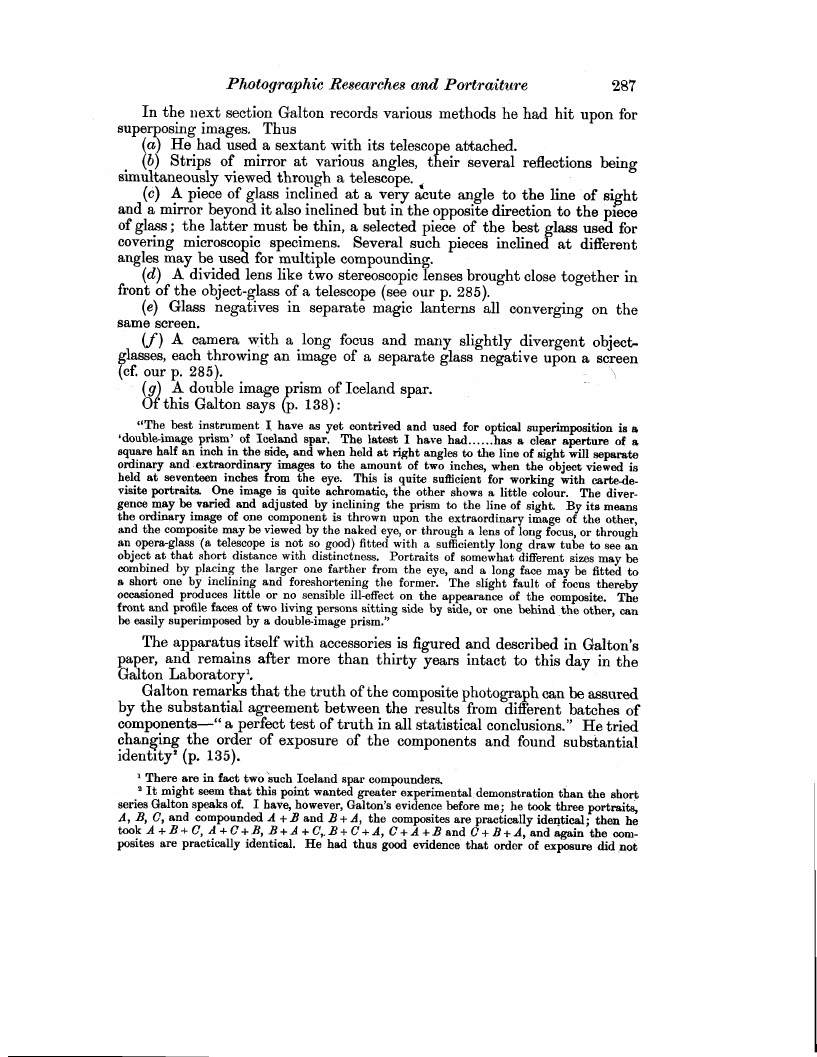Photographic Researches and Portraiture 287
In the next section Galton records various methods he had hit upon for superposing images. Thus
(a) He had used a sextant with its telescope attached.
(b) Strips of mirror at various angles, their several reflections being simultaneously viewed through a telescope. .
(c) A piece of glass inclined at a very acute angle to the line of sight and a mirror beyond it also inclined but in the opposite direction to the piece of glass ; the latter must be thin, a selected piece of the best glass used for covering microscopic specimens. Several such pieces inclined at different angles may be used for multiple compounding.
(d) A divided lens like two stereoscopic lenses brought close together in front of the object-glass of a telescope (see our p. 285).
(e) Glass negatives in separate magic lanterns all converging on the same screen.
(f) A camera with along focus and many slightly divergent objectglasses, each throwing an image of a separate glass negative upon a screen (cf. our p. 285).
(g) A double image prism of Iceland spar.
Of this Galton says (p. 138)
"The best instrument I have as yet contrived and used for optical superimposition is a 'double-image prism' of Iceland spar. The latest I have had has a clear aperture of a square half an inch in the side, and when held at right angles to the line of sight will separate ordinary and, extraordinary images to the amount of two inches, when the object viewed is held at seventeen inches from the eye. This is quite sufficient for working with carte-devisite portraits. One image is quite achromatic, the other shows a little colour. The divergence may be varied and adjusted by inclining the prism to the line of sight. By its means the ordinary image of one component is thrown upon the extraordinary image of the other, and the composite may be viewed by the naked eye, or through a lens of long focus, or through an opera-glass (a telescope is not so good) fitted with a sufficiently long draw tube to see an object at that short distance with distinctness. Portraits of somewhat different sizes may be combined by placing the larger one farther from the eye, and a long face may be fitted to a short one by inclining and foreshortening the former. The slight fault of focus thereby occasioned produces little or no sensible ill-effect on the appearance of the composite. The front and profile faces of two living persons sitting side by side, or one behind the other, can be easily superimposed by a double-image prism."
The apparatus itself with accessories is figured and described in Galton's paper, and remains after more than thirty years intact to this day in the Galton Laboratory'.
Galton remarks that the truth of the composite photograph can be assured by the substantial agreement between the results from different batches of components-" a perfect test of truth in all statistical conclusions." He tried changing the order of exposure of the components and found substantial identity' (p. 135).
' There are in fact two such Iceland spar compounders.
$ It might seem that this point wanted greater experimental demonstration than the short series Galton speaks of. I have, however, Galton's evidence before me; he took three portraits, A, B, C, and compounded A + B and B + A, the composites are practically identical; then he took A+B+C, A+C+B, B+A+C,,B+C+A, C+A+B and C+B+A, and again the composites are practically identical. He had thus good evidence that order of exposure did not

